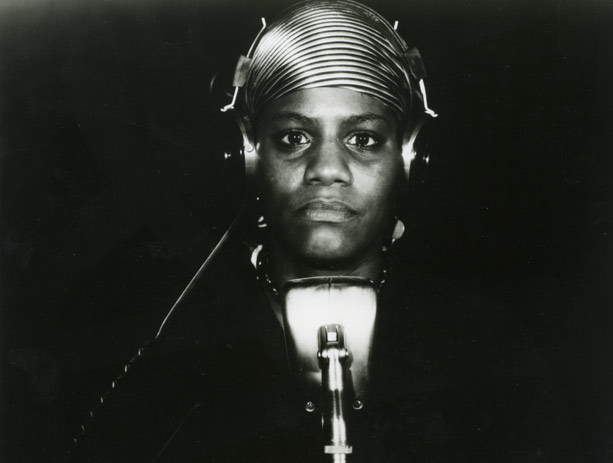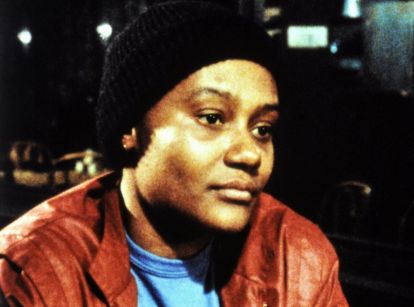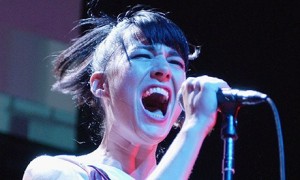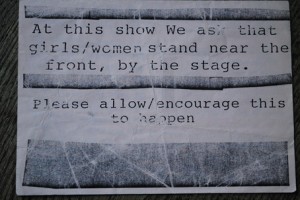Written by staff writer Heather Brown, this re-post appears as part of our theme week on Ladies of the 1980s.
What is the role of difference in feminism? When in doubt, ask Audre Lorde. In 1980, she delivered a lecture entitled “Age, Race, Class, and Sex: Women Redefining Difference” (later published in Sister Outsider) in which she states, “There is a pretense to homogeneity of experience covered by the word sisterhood that does not in fact exist.” It’s no coincidence to me that three years later Lizzie Borden would direct Born in Flames, a film that depicts a collection of different feminist voices all aligned in a common goal of resisting what bell hooks terms the white-supremacist-capitalist-patriarchy.
The film takes place 10 years after a social revolution in the United States (!). However, despite the political structure of a socialist democracy, social, and economic justice for the historically marginalized is still a long way off. Filmed in cinema verité style with non-professional actors and against the backdrop of Reagan-era New York City, the post-revolution future looks appropriately gritty, unflinching, and chaotic — much like the film’s narrative. So, too, are the voices of feminist activists that structure the film. First, we meet Adelaide Norris (Jean Satterfield) an African American woman who, along with Hilary Hurst (Hilary Hurst), a white woman, leads the Women’s Army. Both are disenfranchised by the government’s “work-fair” program, and we see them work to mobilize their respective communities across racial lines. And most importantly, we see them disagree about how to do it. Adelaide, influenced by her mentor Zella (played by the late feminist activist Florynce Kennedy), weighs the necessity of the Women’s Army to take up arms against the state, which has only ever perpetuated militarized violence toward women, lesbians, communities of color, and the poor in general. Zella tells Adelaide, “All oppressed people have a right to violence.”
In addition to seeing women converse with and debate one another, we also see them speaking from dedicated feminist platforms on pirate radio. Isabel (Adele Bertei), the DJ of Radio Ragazza, is an outspoken critic of the Women’s Army. She and her community represent the white, anarchist-punk perspective that promotes creative resistance through art. Then there’s Honey (Honey) of Phoenix Radio, a DJ who Adelaide seeks as an ally by extension of overlap of their membership in Black communities. Yet another voice is the Socialist Youth Review, a liberal magazine whose reporters (white women, including a young Kathryn Bigelow) occasionally weigh in to critique the Women’s Army for its agenda and question the need for it to exist at all, given the social gains achieved by the revolution. And finally, a distinctly anti-feminist perspective that provides a counter-narrative to the action unfolding is the voiceover of FBI agents, who aim to take down the Women’s Army, starting with Adelaide Norris. We hear them remark, “We don’t know who to find out who is charge” and “it’s not clear how they function.” These statements reveal just how confounding it is to the very centralized government that a social movement could share authority amongst its members.
One of the ways that the Women’s Army shares this authority is shared is through collective anti-street harassment activism and anti-rape squads. In a harrowing but triumphant scene, a woman is being assaulted by two women on her way to the subway, and out of nowhere appears a fleet of women on bicycles, blowing whistles and circling the men. The men leave the scene and the Women’s Army come to the aid of the attack victim. What is particularly important about this scene is not just how little things have changed when it comes to the endurance of street harassment and violence against women, but that the Women’s Army creates its own policing solutions to these problems. Instead of acting out carceral feminism, which relies on law enforcement and state violence to combat violence against women, the feminisms of Born in Flames create justice rather than restore “order.”
Though much is made of the differences between the activist groups, one thread runs through the film: the shared experience of work. There are several montages — set to the soundtrack of Red Krayola’s “Born in Flames,” which will get lodged in your brain for weeks — in which close-up shots of hands and all kinds of bodies are engaged in all kinds of labor. From bagging groceries, to child care, to sex work, each act is equated as valuable in its own right. One of the acts of resistance occurs after Adelaide, like many other women who are lower in the social caste, is laid off from her construction job and organizes a demonstration to fight for jobs that have the potential for growth.
The film’s rising action occurs when Adelaide is detained by the FBI on suspicion of arms trafficking — a fabrication intended to stamp out her and the Women’s Army. Without spoiling the film, let’s just say that the different feminist subgroups are called to combine their efforts and create Phoenix Regazza Radio to stand in solidarity as they enact a final act of terrorism. While this particular act is a bit chilling to watch post-9/11, it powerfully symbolizes the danger that will befall society should the marginalization of women and the white-supremacist-capitalist-patriarchy persist.
Heather Brown is a Bitch Flicks staff writer. She grew up in Connecticut but hopes that having lived in Virginia and North Carolina — and being married to an Arkansan — gives her occasional license to have a Southern accent. She recently fled a full-time job as a professor in central New Jersey, where she taught classes in gender studies, feminist theory, linguistics, and rhetoric. Long story short, she decided to leave the ivory tower to have more fun on the outside. Now she teaches online part-time, works as a freelance writer and instructional designer, and is currently pursuing professional coach certification training in Chicago, Ill., where she moved at the end of 2013 with her partner and cat, Edie. She lives for live music, road trips, and good movies. She blogs sporadically at PhDilettante.












